I’ve always been intrigued by illuminated manuscripts. Owning (or even holding) an ancient biblical or devotional vellum manuscript illuminated by monks from the 14th century (or earlier) would be amazing.
When I see the modern illumination work of Barbara Wolff, who spent decades illustrating science textbooks and nature guides before learning the skills of illumination, I am awed. Her work lights up the texts, combining the tradition of illumination with meticulous accuracy, creating pages that are vibrant, intricate works of art. Add the fact that she is illustrating the poetic and beautiful words of Psalm 104, and you have a remarkable achievement of art combining tradition and modernity.
Historically, due to the huge expense of labor and materials required, most illuminated manuscripts were commissioned by patrons and these modern-day manuscripts were commissioned as well. This folio and Barbara Wolff's other work Rose Haggadah were commissioned by philanthropists Daniel and Joanna S. Rose and then donated to the Morgan Library & Museum in New York City.
To begin this post, I pair the text of Psalm 104 with images of pieces from this collection (in their appropriate places) for you to enjoy and perhaps meditate upon.
Praise the Lord, my soul.
Lord my God, you are very great;
you are clothed with splendor and majesty.
The Lord wraps himself in light as with a garment;
he stretches out the heavens like a tent
and lays the beams of his upper chambers on their waters.
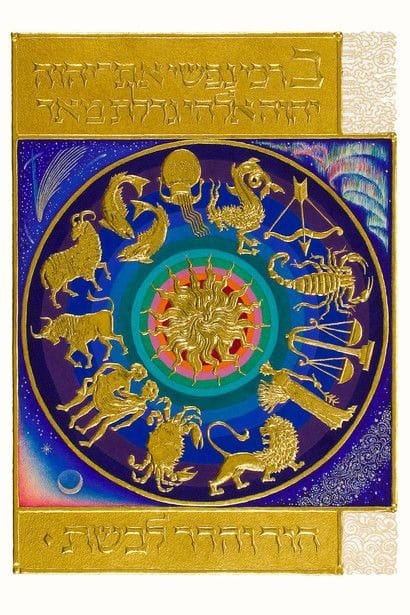
He makes the clouds his chariot
and rides on the wings of the wind.
He makes winds his messengers,
flames of fire his servants.
He set the earth on its foundations;
it can never be moved.
You covered it with the watery depths as with a garment;
the waters stood above the mountains.
But at your rebuke the waters fled,
at the sound of your thunder they took to flight;
they flowed over the mountains,
they went down into the valleys,
to the place you assigned for them.
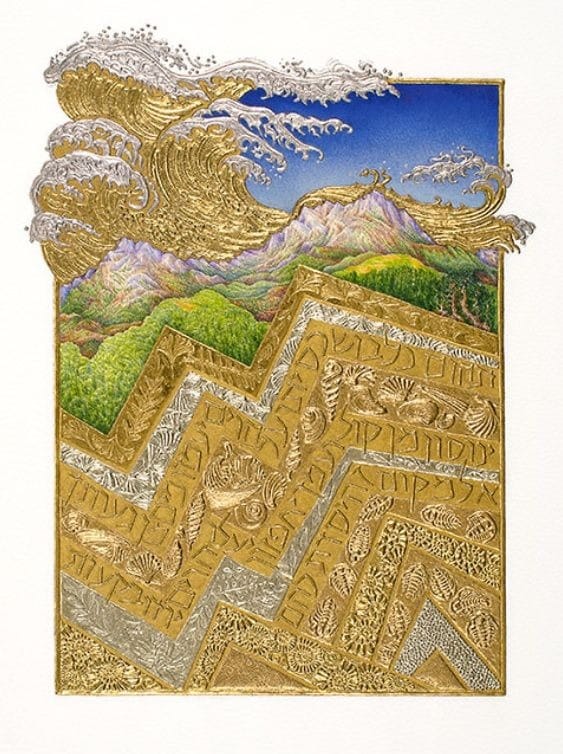
You set a boundary they cannot cross;
never again will they cover the earth.
He makes springs pour water into the ravines;
it flows between the mountains.
They give water to all the beasts of the field;
the wild donkeys quench their thirst.
The birds of the sky nest by the waters;
they sing among the branches.
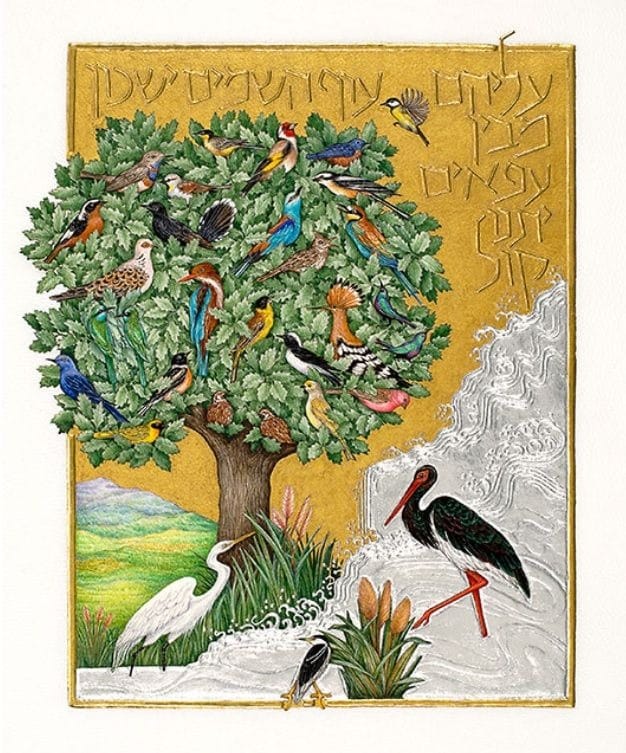
He waters the mountains from his upper chambers;
the land is satisfied by the fruit of his work.
He makes grass grow for the cattle,
and plants for people to cultivate—
bringing forth food from the earth:
wine that gladdens human hearts,
oil to make their faces shine,
and bread that sustains their hearts.
The trees of the Lord are well watered,
the cedars of Lebanon that he planted.
There the birds make their nests;
the stork has its home in the junipers.
The high mountains belong to the wild goats;
the crags are a refuge for the hyrax.
He made the moon to mark the seasons,
and the sun knows when to go down.
You bring darkness, it becomes night,
and all the beasts of the forest prowl.

The lions roar for their prey
and seek their food from God.
The sun rises, and they steal away;
they return and lie down in their dens.
Then people go out to their work,
to their labor until evening.
How many are your works, Lord!
In wisdom you made them all;
the earth is full of your creatures.
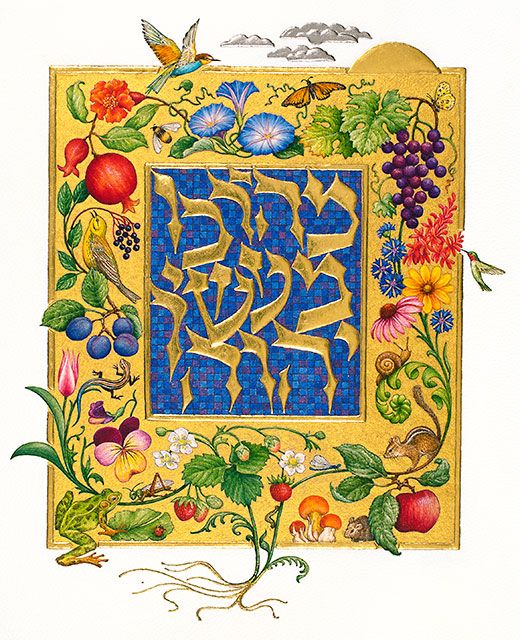
There is the sea, vast and spacious,
teeming with creatures beyond number—
living things both large and small.
There the ships go to and fro,
and Leviathan, which you formed to frolic there.
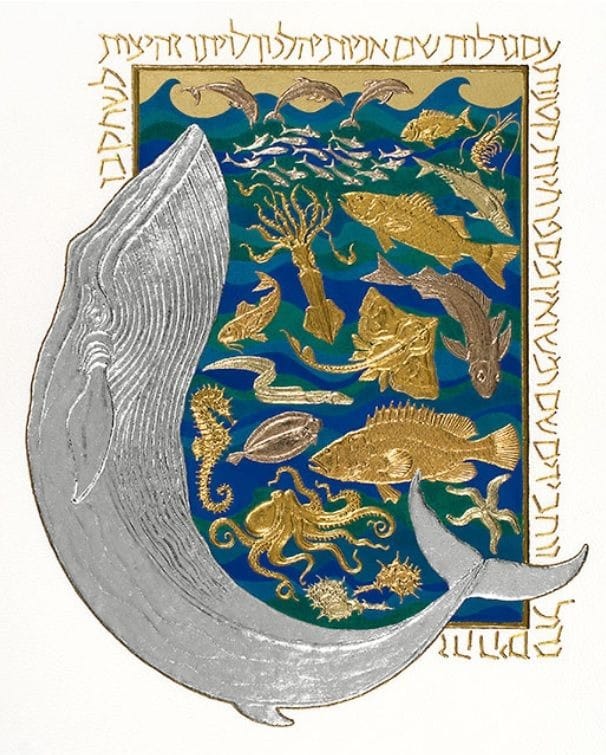
All creatures look to you
to give them their food at the proper time.
When you give it to them,
they gather it up;
when you open your hand,
they are satisfied with good things.
When you hide your face,
they are terrified;
when you take away their breath,
they die and return to the dust.
When you send your Spirit,
they are created,
and you renew the face of the ground.
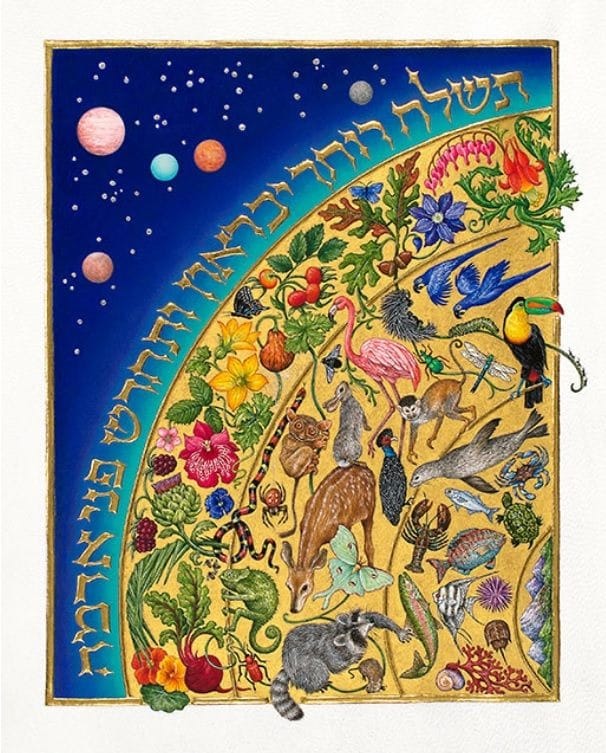
May the glory of the Lord endure forever;
may the Lord rejoice in his works—
he who looks at the earth, and it trembles,
who touches the mountains, and they smoke.
I will sing to the Lord all my life;
I will sing praise to my God as long as I live.
May my meditation be pleasing to him,
as I rejoice in the Lord.
But may sinners vanish from the earth
and the wicked be no more.
Praise the Lord, my soul.
Praise the Lord.
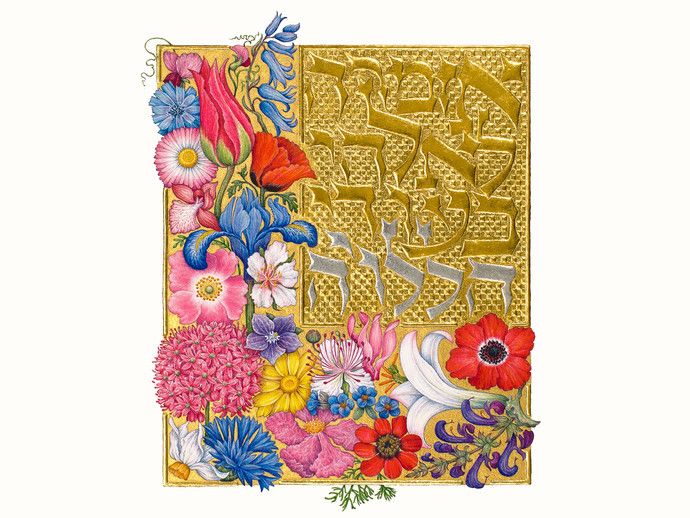
Barbara Wolff’s illuminations of Psalm 104 are certainly lovely to look at, but they are more than just beautiful works of art. They picture a cohesive creation, life intertwined and bountiful, with parts functioning together and separately, all in their intended sphere. The abundance of the life portrayed doesn't quite fit within the frames of the pages, however; each illustration bursts out a little here or there from the borders of the manuscript, be it a root, or a bird, or waves. This earth is full and overflowing with creation.
The colors of her pages are bright and deep. She works with calf or goatskin parchment, various weights and shades of gold, silver and platinum leaf, and grinds azurite, malachite, and lapis lazuli stones to create the unique Medieval blues and greens in this folio. These same materials were used for the illuminated manuscripts of the Middle Ages and are the reason for the great expense that was involved in making them. (Some larger manuscripts would require an entire herd of animals for the skins that made up the parchment).
Wolff's background as a textbook illustrator and nature guide illustrator is evident in how she honors things by accurately portraying them in her art. Her drawings are identifiable species—not generic or stylized representations, but actual specific species.
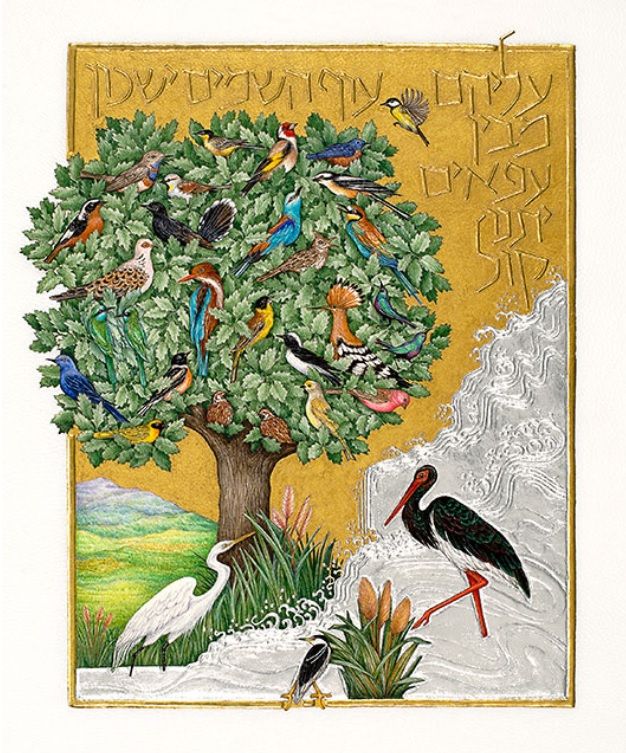
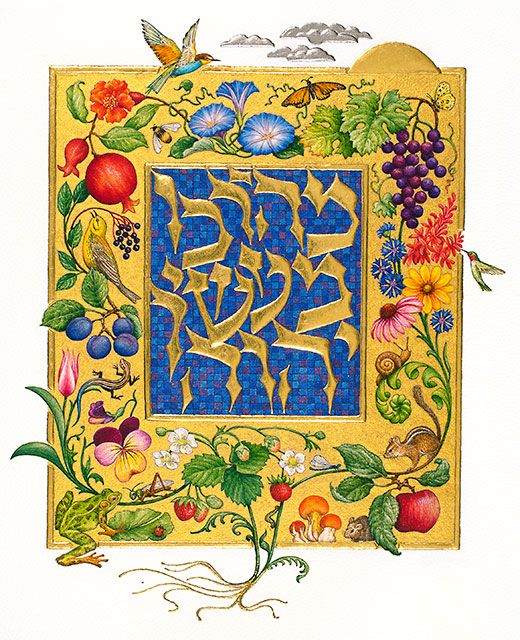
For instance, taking a closer look at Among the Branches They Sing, the birds in the tree are not fantasy birds, but actual birds, 28 types to be specific: a night heron, a white egret, a Eurasian Hoopoe, a European bee-eater, a Moussier's redstart, to name a few. And these identifiable birds are not perched on a made-up tree, but on a specific tree—a Tabor oak. The artist shows respect for the region of origin by drawing birds that are native or migratory to the Mediterranean region from which the text originated. It roots the text in the place where it was written.
In The Earth is Full of Thy Creatures, the animals and plants are equally detailed and accurate. The plants are real plants: strawberries, pansies, asters. I have no doubt that with a little work, a specific name could be put to each of the plant and animal species in all the pictures. This matters because the psalm isn't about a theoretical creation, it's about a real, material, specific creation that God made, established and loves. God made this particular world. God loves this particular world. God entrusted this particular world with its particular inhabitants to our care. He doesn't love the idea of a creation; he loves the creation itself.
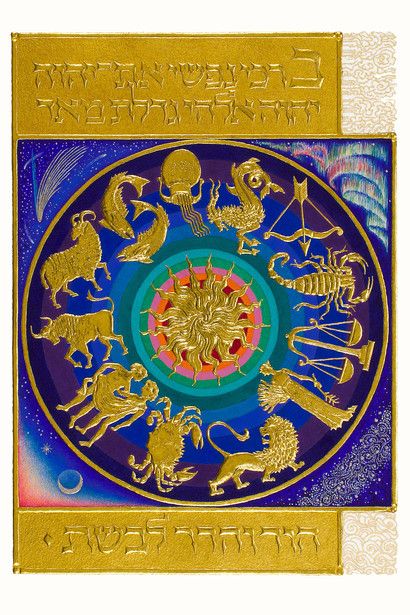
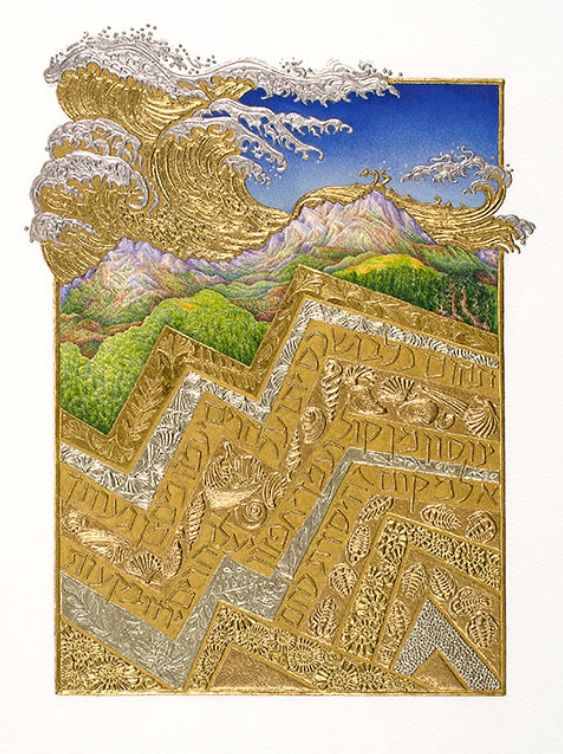
But that doesn't mean the pieces are completely literal. Particularly in the two pieces directly above, you see Wolff's imagination at work. In Who Stretches Out the Heavens, the establishment of the heavens and the earth are pictured with movement, power, and imagination. In the heavens picture, the firmament swirls with light and color in the corners. The pattern of time in the center seems to have been pulled out and constructed from the elements of color and light that are outside the circle. It is an imaginative representation of God constructing months and seasons to contain the movement of time.
In And the Mountains Rose, showing the formation of the inhabitable world, layers of fossils, dirt and sediment push up into the picture, waves roar against the mountain, portraying a feeling of restrained power, held in check by the design of the creator of this habitat for the creatures which will live here. Again, it is the artist's picture of what the establishment of the earth might have looked like.
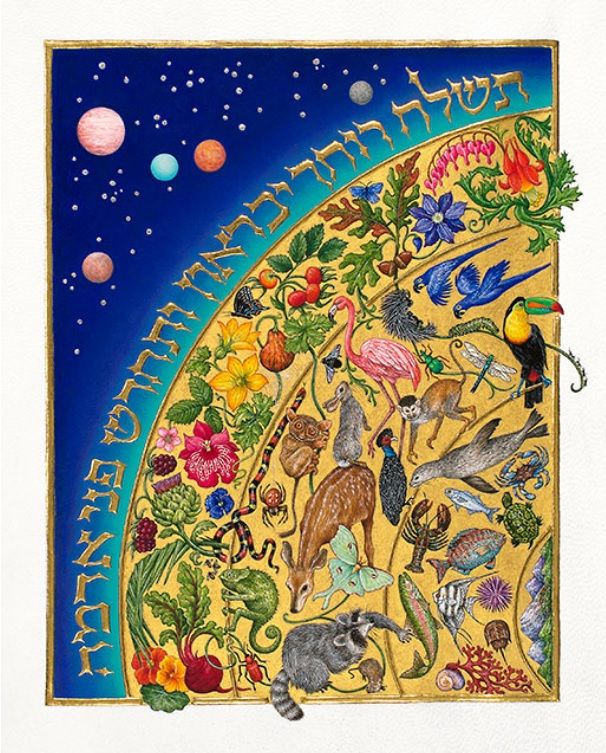
Probably my favorite of the collection, You Renew the Face of the Earth, combines the artist's technical accuracy, imagination, and astounding colors. Wolff layers the pieces of the creation: the heavens, the vegetation, the animals on land and air, the creatures of the water, and finally the earth itself into a dazzling picture slice of our planet. Again, the identifiable flora and fauna. Even the planets are not generic planets, but appear to be our planets: Uranus, Mars, Mercury, Venus.
All of creation, plants and animals from around the globe, are brought together in this picture of God's renewal of the face of the earth. This is the whole of creation, together, everything in its own space, but unified in a way that represents both the picture of creation presented in Psalm 104 and the creation story of Genesis 1. Although there is no image of humans included, the script encircling the globe establishes their part in this creation. All are thriving—the fruit is ripe, the flowers are blooming, the animals are alive and healthy. The image radiates the renewal that it announces and, as a work of art, itself offers a perspective that can renew and refresh.
Reflection Questions: Pick one of the pictures to meditate upon for a few minutes. What do you notice that helps you appreciate this created world? Look around you for the same renewal you see in this picture and read of in the Psalm—can you recognize it?
To see all ten folios of You Renew the Face of the Earth, as well as other illuminated manuscripts and videos about Barbara Wolff, visit the artist's website.
Louise
Click here to leave a COMMENT or SHARE this post
You can contact me directly at info@circlewood.online.
To learn more about The Ecological Disciple's parent organization, visit the Circlewood website.
Don't miss a post! By subscribing to The Ecological Disciple, you will receive new posts directly through email every Monday and Thursday. It's easy and free, and you can unsubscribe at any time.